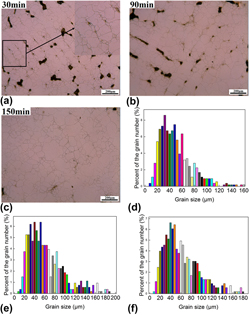Crossref Citations
This article has been cited by the following publications. This list is generated based on data provided by
Crossref.
Chen, R.C.
Hong, C.
Li, J.J.
Zheng, Z.Z.
and
Li, P.C.
2017.
Austenite grain growth and grain size distribution in isothermal heat-treatment of 300M steel.
Procedia Engineering,
Vol. 207,
Issue. ,
p.
663.
Chen, Yong-feng
Xie, Jian-bo
Wu, Yan-xin
and
Fu, Jian-xun
2019.
Austenite Grain Growth Behavior of 30BF Steel Before Rough Rolling.
Metals and Materials International,
Vol. 25,
Issue. 4,
p.
1072.
Wang, Qinghai
Ye, Qibin
Wang, Wenbo
Deng, Xiangtao
and
Wang, Zhaodong
2019.
In Situ Observation of Austenite Grain Growth and Phase Transformation of A517GrQ Rack Steel for Jack-Up Offshore Platform.
IOP Conference Series: Materials Science and Engineering,
Vol. 562,
Issue. 1,
p.
012126.
Li, Zhiqiang
Wang, Junsheng
and
Huang, Houbing
2019.
A new-curvature cellular automata model of austenite grain growth.
Materials Research Express,
Vol. 6,
Issue. 9,
p.
0965b5.
Fuyong, SU
Wenli, LIU
and
Zhi, WEN
2020.
Three-dimensional cellular automaton simulation of austenite grain growth of Fe-1C-1.5Cr alloy steel.
Journal of Materials Research and Technology,
Vol. 9,
Issue. 1,
p.
180.
Cui, Li
2020.
A new fatigue damage accumulation rating life model of ball bearings under vibration load.
Industrial Lubrication and Tribology,
Vol. 72,
Issue. 10,
p.
1205.
Xu, Yue
Liu, Jiansheng
Zhao, Yu
and
Jiao, Yongxing
2021.
Austenite grain growth kinetics and mechanism of grain growth in 12Cr ultra-super-critical rotor steel.
Philosophical Magazine,
Vol. 101,
Issue. 1,
p.
77.
Li, En
Li, Changsheng
Han, Yahui
Ren, Jinyi
Gao, Cairu
and
Qiu, Chunlin
2021.
Dendrite structure and microhardness of as-cast 4Cr5MoSiV1 steel between different homogenisation processes.
Materials Science and Technology,
Vol. 37,
Issue. 18,
p.
1465.
Benmaziane, Sara
Lenda, Omar Ben
Saissi, Soukaina
Zerrouk, Latifa
and
Saad, Elmadani
2022.
Modeling of Austenite Grain Growth Behavior for AISI 302 Stainless Steel.
Recent Patents on Mechanical Engineering,
Vol. 15,
Issue. 5,
p.
486.
Mochtar, Myrna Ariati
Fatriansyah, Jaka Fajar
Suhariadi, Iping
and
Harefa, Valen Befri
2022.
Numerical Prediction of Austenite Grain Growth Characteristic of AISI O1 Alloy Steel.
Journal of Materials Engineering and Performance,
Ben Lenda, Omar
El Hamzi, Sara
Hafdi, Houyem
Zerrouk, Latifa
Saad, El Madani
Benhala, B.
Raihani, A.
Boukili, B.
Sallem, A.
and
Qbadou, M.
2023.
Microstructure, macro-, and nano-hardness assessment of AISI 302 steel aged at 1000°C.
E3S Web of Conferences,
Vol. 469,
Issue. ,
p.
00094.
Rezaei, Javad
Habibi Parsa, Mohammad
and
Mirzadeh, Hamed
2023.
Phase transformation kinetics of high-carbon steel during continuous heating.
Journal of Materials Research and Technology,
Vol. 27,
Issue. ,
p.
2524.
Zhao, Qiancheng
Luo, Hong
Pan, Zhimin
Wang, Xuefei
and
Cheng, Hongxu
2023.
Study on mechanical properties of rare earth elements modified high carbon chromium bearing steel.
Materials Today Communications,
Vol. 34,
Issue. ,
p.
105329.
Zhao, Qiancheng
Wang, Xuefei
Pan, Zhimin
Wei, Ya
Cheng, Hongxu
Ma, Yicong
Luo, Hong
and
Li, Xiaogang
2023.
Effects of rare earth elements addition on mechanical properties and corrosion behavior of GCr15 bearing steel under different heat treatment conditions.
Corrosion Communications,
Vol. 9,
Issue. ,
p.
65.
Peterson, Luke
Horstemeyer, Mark
Lacy, Thomas
and
Moser, Robert
2023.
Using an Internal State Variable Model Framework to Investigate the Influence of Microstructure and Mechanical Properties on Ballistic Performance of Steel Alloys.
Metals,
Vol. 13,
Issue. 7,
p.
1285.
Ben Lenda, Omar
El Ganich, Hajar
and
Saad, El Madani
2023.
Microstructure, Nano-, and Macro-Indentation Characterization of AISI 302 Steel After High-Temperatures Aging.
East European Journal of Physics,
p.
267.
Li, Dezhi
Zhao, Xianming
Zhang, Hongliang
Li, Jie
and
Han, Huaibin
2024.
The effect of network cementite dissolution on the nucleation and growth of prior austenite grains in high carbon low alloy steels.
Journal of Materials Research and Technology,
Vol. 30,
Issue. ,
p.
565.






